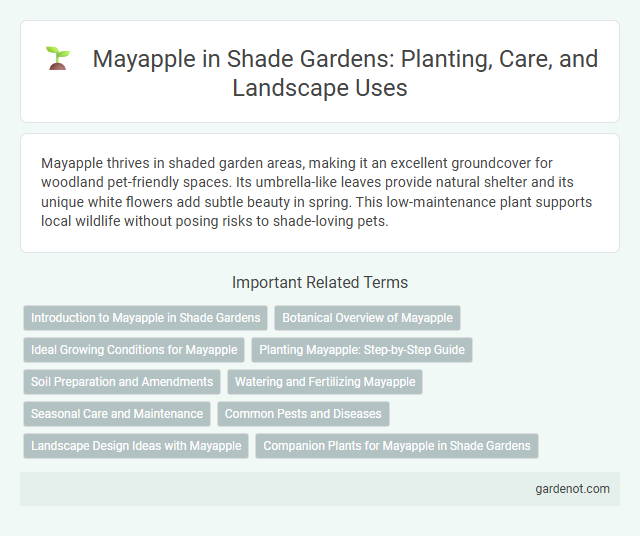Mayapple thrives in shaded garden areas, making it an excellent groundcover for woodland pet-friendly spaces. Its umbrella-like leaves provide natural shelter and its unique white flowers add subtle beauty in spring. This low-maintenance plant supports local wildlife without posing risks to shade-loving pets.
Introduction to Mayapple in Shade Gardens
Mayapple (Podophyllum peltatum) thrives in shaded garden environments, making it a valuable native perennial for woodland landscapes. Its umbrella-shaped leaves provide ground cover while concealing its delicate white flowers that bloom in spring. Adapted to moist, well-drained soils, Mayapple supports local ecosystems by offering habitat and attracting pollinators in shaded garden settings.
Botanical Overview of Mayapple
Mayapple (Podophyllum peltatum) is a perennial herbaceous plant native to eastern North American woodlands, thriving in partial to full shade environments. It features umbrella-like leaves with deeply lobed edges and produces a single white flower in spring that develops into a small yellow fruit. The plant's rhizomatous roots spread underground, allowing it to form dense colonies, making it an ideal groundcover for shaded garden areas.
Ideal Growing Conditions for Mayapple
Mayapple thrives in shaded woodland environments with moist, well-drained soil rich in organic matter. It prefers partial to full shade, mimicking its natural habitat under deciduous tree canopies. Consistent moisture and protection from direct sunlight ensure optimal growth and vibrant foliage.
Planting Mayapple: Step-by-Step Guide
Plant Mayapple in shaded, well-drained soil during early spring, spacing rhizomes 12-18 inches apart to accommodate their spread. Ensure the soil remains consistently moist but not waterlogged to promote healthy growth and prevent rot. Mulch around the plants to retain moisture and suppress weeds, supporting robust development of Mayapple colonies.
Soil Preparation and Amendments
Mayapple thrives in rich, well-drained, acidic to neutral soil with a pH of 5.5 to 7.0, ideal for shade gardens. Incorporate organic matter such as compost or leaf mold to enhance soil fertility and moisture retention. Avoid heavy clay soils by amending with coarse sand or perlite to improve drainage and prevent root rot.
Watering and Fertilizing Mayapple
Mayapple thrives in consistently moist, well-drained soil, requiring regular watering to prevent drying out, especially during dry spells. Fertilize with a balanced, slow-release organic fertilizer in early spring to support healthy growth and vibrant foliage. Avoid excessive fertilization, which can lead to weak stems and reduced flowering.
Seasonal Care and Maintenance
Mayapple thrives in shaded woodland gardens with consistently moist, well-drained soil, benefiting from spring and early summer watering to support leaf and flower development. Deadhead spent blooms and trim back foliage after the plant goes dormant in late summer to promote healthy regrowth and prevent disease. Applying a layer of organic mulch in early spring helps retain soil moisture and regulate temperature, optimizing Mayapple's seasonal growth cycle.
Common Pests and Diseases
Mayapple (Podophyllum peltatum) often faces challenges from pests such as aphids, Japanese beetles, and slugs that can damage foliage and reduce plant vigor. Powdery mildew and rust diseases occasionally affect Mayapple, causing leaf discoloration and stunted growth, especially in poorly ventilated, damp shade gardens. Effective control involves maintaining proper spacing for air circulation and using insecticidal soap to manage pest outbreaks.
Landscape Design Ideas with Mayapple
Mayapples (Podophyllum peltatum) thrive in shade gardens, offering unique umbrella-like foliage that enhances woodland landscape designs with natural texture and seasonal interest. Their springtime white flowers and subsequent yellow fruit attract pollinators, adding biodiversity to shaded areas beneath trees and shrubs. Incorporating Mayapples into mulched beds or naturalized areas provides low-maintenance ground cover that complements ferns and hostas for a cohesive, serene shade garden aesthetic.
Companion Plants for Mayapple in Shade Gardens
Mayapple thrives alongside ferns, hostas, and Solomon's seal, which share similar shade and moisture requirements, creating a harmonious understory environment. These companion plants not only enhance the aesthetic appeal of shade gardens but also help maintain soil moisture and prevent weed growth. Integrating native woodland species like trilliums and bloodroot further supports local ecosystems while complementing Mayapple's distinctive foliage.
Mayapple Infographic

 gardenot.com
gardenot.com